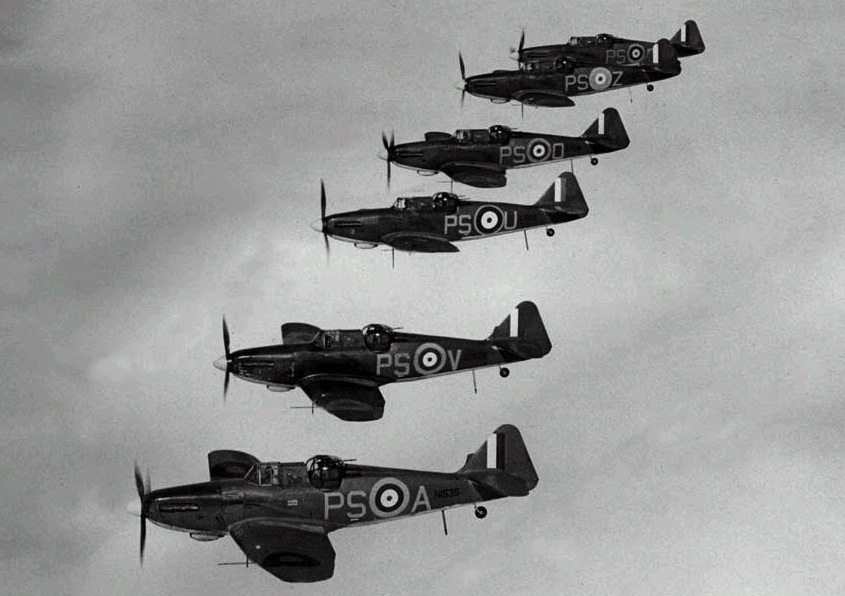THE BALANCE SHEET MAY 13TH 1940
Within days of the German assault on Holland on May 10, 1940, it became clear that the air defences on the continent were insufficient to counter the weight of the Luftwaffe. As a consequence, RAF fighter units based in southern England were deployed in support of British Air Force in France (BAFF) squadrons and for most it would be their baptism of fire. Tragically, for some young pilots their first experience of combat would also prove to be their last.
One such action took place early in the morning of Easter Monday, May 13, 1940, over southern Holland and involved a flight of six Boulton Paul Defiant reconnaissance fighters of No. 264 Squadron. It was the first time that No. 264 Squadron encountered enemy fighters, their first action of the war only having taken place the previous day against single unescorted bombers. It proved a sobering experience.
Of the six aircraft on the mission, five were shot down and only one returned to base to report on the disaster. Of the 12 crew members involved, three were killed, three were captured by the Germans, and four others ended up having to make their way back to Britain.
The action presaged the brutal realities of combat the Defiant squadrons were to face over the Channel in the coming weeks as the serious limitations of the Defiant as a day fighter became pitifully exposed.

(King)
The day before, May 12, the six Defiants of 'B' Flight of No. 264 Squadron had left Duxford for Martlesham Heath at 1900 hours to be ready for take-off from the latter airfield on the morrow. The following morning, May 13, they were airborne from Martlesham at 04.15 hours and flew together with six Spitfires of 'A' Flight of No. 66 Squadron, their mission being to patrol the Dutch coast between IJmuiden and The Hague with the object of attacking German troop transports. ‘B' Flight consisted of Blue and Green sections with the following aircraft:
Blue 1: Defiant L6969 with Flight Lieutenant G. F. A. Skelton and Pilot Officer J. E. Hatfield.
Blue 2: Defiant L6958 with Pilot Officer S. R. Thomas and LAC J. S. M. Bromley.
Blue 3: Defiant L6960 with Pilot Officer G. E. Chandler and LAC D. L. McLeish.
Green 1: Defiant L6977 with Pilot Officer P. E. J. Greenhous and Sergeant F. D. Greenhalgh.
Green 2: Defiant L6965 with Pilot Officer A. M. McLeod and LAC W. E. Cox.
Green 3: Defiant L6974 with Pilot Officer D. H. S. Kay and LAC E. J. Jones.
Both British and German pilots involved in the action of May 13, 1940 claim a considerable number of aircraft lost by both sides, British official sources being slightly more cautious than the German. The RAF Fighter Command Summary of the action records that Nos. 264 and 66 Squadrons initially claimed to have shot down 12 enemy aircraft (ten Ju 87 Stukas and two Bf 109s) although only five Stukas were subsequently allowed by HQ Intelligence No. 12 Group.

(King)
The latter tally was in fact correct in number though not in type of aircraft. The Stuka unit involved in the action, 12.(St) Staffel of Lehrgeschwader 1, lost only four aircraft that morning. Stuka L1+HW (Werk-Nr. 5513) crashed near Werkendam killing the wireless operator, Gefreiter Günther Langner, and wounding the pilot, Unteroffizier Wilhelm Bienk.
Another Stuka, flown by Feldwebel Karl Zieseman and his radioman Unteroffizier Günther Jordan, who both managed to bail out in time, came down in the so-called ‘Buisjes’ in the Biesbosch. A third Stuka (Werk-Nr. 278) crashed between Almkerk and Waardhuizen after its crew, Unteroffizier Hans Kowatsch and Unteroffizier Hans Jorzyck, managed to abandon the aircraft.
Leutnant Günther Schmidt and Unteroffizier Hermann Witteborn succeeded in landing their badly damaged Ju 87 B-1 on Neuenkamp airfield, but the aircraft overturned and was a write-off. The fifth German aircraft lost belonged to the fighter escort, 5./JG26 losing the Bf 109 flown by Leutnant Karl Borris who crashed near Numansdorp, the pilot returning to his unit four days later.
On the German side, 5./JG26 claimed to have shot down nine enemy aircraft (eight Spitfires and one Defiant), the sad outcome actually being that No. 264 Squadron lost five Defiants as described, and No. 66 Squadron one Spitfire – N3027 of Flight Officer George Brown who crashed at Aalter aerodrome landing on a burst tyre.
Adapted from the book Luchtgevechten boven West-Brabant en de Biesbosch by Jan Jolie for the Aircrew Remembrance Society (Lorelax Productions, 2000).


The British Library is preserving this site for the future in the UK Web Archive at www.webarchive.org.uk All Aircrew Remembered on our Remembrance pages, are therefor not just remembered here, but also subsequently remembered and recorded as part of our nation’s history
and heritage at The British Library.